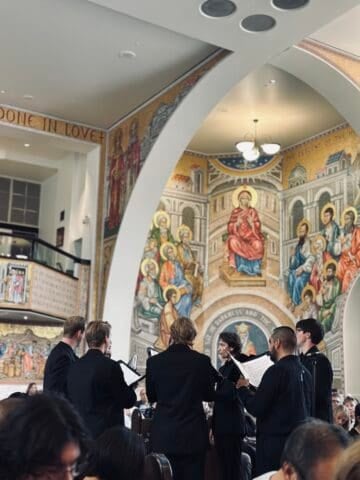Believe it or not, after decades of celebrating Easter around the globe, I only recently heard about an incredible miracle that happens every year on Pascha Night in Jerusalem. It involves flames that appear miraculously and, even more astonishingly, don't burn! This discovery amazed me, and I had to share this extraordinary story with you—so keep reading because it is truly AMAZING!

The miracle of the Holy Fire captivates thousands of Orthodox Christians who gather in the Holy Land, specifically at the Church of the Holy Sepulcher in East Jerusalem each Pascha (Easter) season. In this post, you'll discover precisely what the miracle is, how it unfolds, its historical significance dating back to the fourth century, and the deeply personal experiences believers have shared.
1. What is the Miracle of the Holy Fire?
The miracle of the Holy Fire, also known as the miracle of the Holy Light, is an extraordinary event that takes place annually at the ancient Church of the Holy Sepulchre on Holy Saturday, also called the Saturday of Light, the day before Pascha. Orthodox Christians believe this miraculous fire spontaneously ignites from within the tomb of Jesus Christ, symbolizing His resurrection. This divine light represents Christ's victory over death, illuminating the spiritual lives of Orthodox Christians worldwide.
Historical Roots
- The miracle dates back to at least the fourth century, with references found in writings from Catholic schools, Orthodox tradition, and ancient church documents.
- It was clearly documented in the 13th century by the Russian Abbot Daniel, who vividly described the miraculous event and ceremony.
- Celebrations involve the Greek Orthodox Patriarch of Jerusalem, the Armenian Patriarch, and other Christian communities, reflecting a rich historical Christian tradition.
- Despite challenges such as the Turkish occupation of Jerusalem and political tensions in East Jerusalem and the West Bank, this miraculous event has continued uninterrupted.


2. How Does the Holy Fire Work?
The Ceremony Begins
The ceremony leading to the miracle involves meticulously observed traditions:
- The Greek Patriarch enters the inner chamber of the tomb of Christ after thorough inspection by Israeli authorities, ensuring no technical means or hidden source of fire are present.
- Officials from other Christian communities, including the Armenian Patriarchate, witness preparations.
- Local Palestinians, Christian Arabs, pilgrims, and tourists fill the streets of the Old City of Jerusalem, chanting traditional hymns such as "Kyrie Eleison" at the top of their voices.

The Miraculous Ignition
- After prayers and chants date back to early Christianity reach their peak, an extraordinary phenomenon occurs—a soft, indefinable light pours forth from the tomb of Jesus.
- The Holy Fire spontaneously ignites oil lamps and candles inside the tomb and quickly spreads throughout the church.
- Joyful shouts of praise erupt, accompanied by the sound of drums, as the miraculous fire rapidly passes from one believer to another.

The Unique Nature of the Flame
- Initially, the Holy Fire has a remarkable property: it doesn't burn when touched.
- For approximately 20 to 30 minutes, pilgrims safely touch the flame, feeling warmth but no pain.
- Witnesses often describe the flame as having an unusual, gentle, moist cloud-like quality, unlike normal fire.

3. Is the Holy Fire a Real Miracle?
Believers' Perspective
Millions of Orthodox Christians firmly believe the Holy Fire is an authentic miracle—an annual affirmation of God's presence and power. It serves as a tangible symbol of Jesus Christ's resurrection, confirming their faith each Paschal season.
Skeptics' Viewpoint
- Critics and skeptics occasionally suggest the Holy Fire could result from natural phenomena or human manipulation.
- Multiple inspections by local authorities—including Israeli authorities and local Palestinian officials—have consistently found no evidence of deception.
- Ultimately, the validity of these ignitions remains a matter of faith rather than human terms.

4. How Hot is Holy Fire?
Temperature of the Flame
- Initially, the Holy Fire is notably cooler than typical flames, making it uniquely safe to handle.
- After about 20 to 30 minutes, it gradually transitions into normal fire capable of causing burns.
Experiences of Believers
- Many pilgrims describe an extraordinary sense of peace when handling the initially cool flame.
- The Holy Fire often displays different hues, including a distinctive blue tint or blue light, enhancing its mystical appearance.
- Witnesses often describe their encounter as profoundly spiritual.

6. How Long Does the Holy Fire Not Burn For?
Duration of Safety
- Immediately after ignition, the Holy Fire remains safe to handle for roughly 20 to 30 minutes.
- This brief window is treasured by believers as an intimate moment of divine grace.
Transition to Normal Fire
- Gradually, the Holy Fire loses its miraculous properties and transitions into typical flames, necessitating caution.

7. How to Visit and Witness the Miracle Yourself
Planning Your Trip
- The miracle occurs annually at the Church of the Holy Sepulchre in East Jerusalem.
- Schedule your visit for Holy Saturday based on the Julian calendar.
- Arrange accommodation and transportation early due to high pilgrim influx.
Navigating the Event
- Arrive extremely early, as streets become crowded quickly.
- Expect heightened security from Israeli authorities.
- Dress modestly and respectfully, observing local customs.
Experiencing the Miracle
- Engage with fellow pilgrims, joining traditional hymns and chants.
- Prepare a candle to receive the flame quickly and safely.
- Allow yourself time to absorb the profound spiritual significance of the moment.

Watch This Video
Watch this amazing video:
Final Take Away
The miracle of the Holy Fire isn't just a religious spectacle; it's a powerful testament to the faith and devotion of Orthodox Christians worldwide. Whether you're a new Christian or deeply rooted in your faith, learning about the miracle of the Holy Fire invites reflection on God’s mysterious and divine power.
Feeling inspired or intrigued by this miraculous event? We'd love to hear your thoughts—leave a comment below! Explore our blog for fasting-friendly recipes and insights to enrich your Paschal celebrations. Let's cherish the miracle of the Holy Fire together!






Comments
No Comments